 Johanna Fateman
Johanna Fateman
The Diné artist expands on sound and embodiment in the space between point and counterpoint.
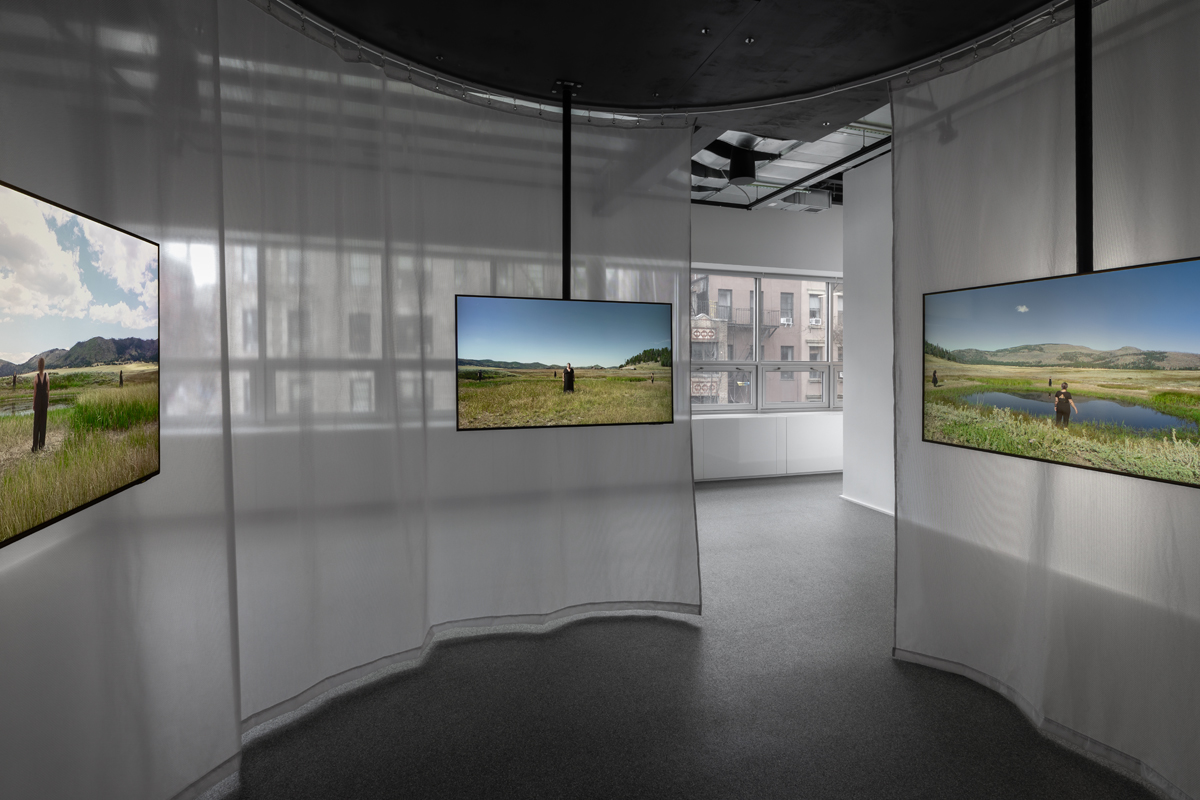
Raven Chacon: A Worm’s Eye View from a Bird’s Beak, installation view. Courtesy Swiss Institute. Photo: Daniel Pérez. Pictured: For Four (Caldera), 2024. Four-channel video and audio.
Raven Chacon: A Worm’s Eye View from a Bird’s Beak, Swiss Institute,
38 St. Marks Place, New York City, through April 14, 2024
• • •
Raven Chacon explains that his music is not concerned with melody or rhythm. Timbre, too, is not a top priority: “What is important is from who or from what the tone originates,” he writes in “Being in a position,” a short, manifesto-like text featured in the monograph accompanying his airy exhibition, A Worm’s Eye View from a Bird’s Beak, at Swiss Institute. The artist, who is Diné, raised in the Navajo Nation, in Fort Defiance, Arizona, dramatizes this quality of his work—the primacy of the social and symbolic meanings of his sound sources—with the first piece viewers encounter. At the ground-floor gallery’s entrance, an olive-drab fabric wall hanging is printed with a diagrammatic performance score. American Ledger No. 1 (Army Blanket) (2020) is, as its label describes, “the creation story of the founding of the United States”—a narrative of violence and erasure, at least thirteen minutes in length. Its events and eras are represented by the sonic effects of chopping wood, throwing coins, the blowing of police whistles, and the lighting of a match, as well as the production of “percussive and bendable tones” by unspecified instruments. Much is left loosely defined, up to the individual and collective interpretative choices of the players.
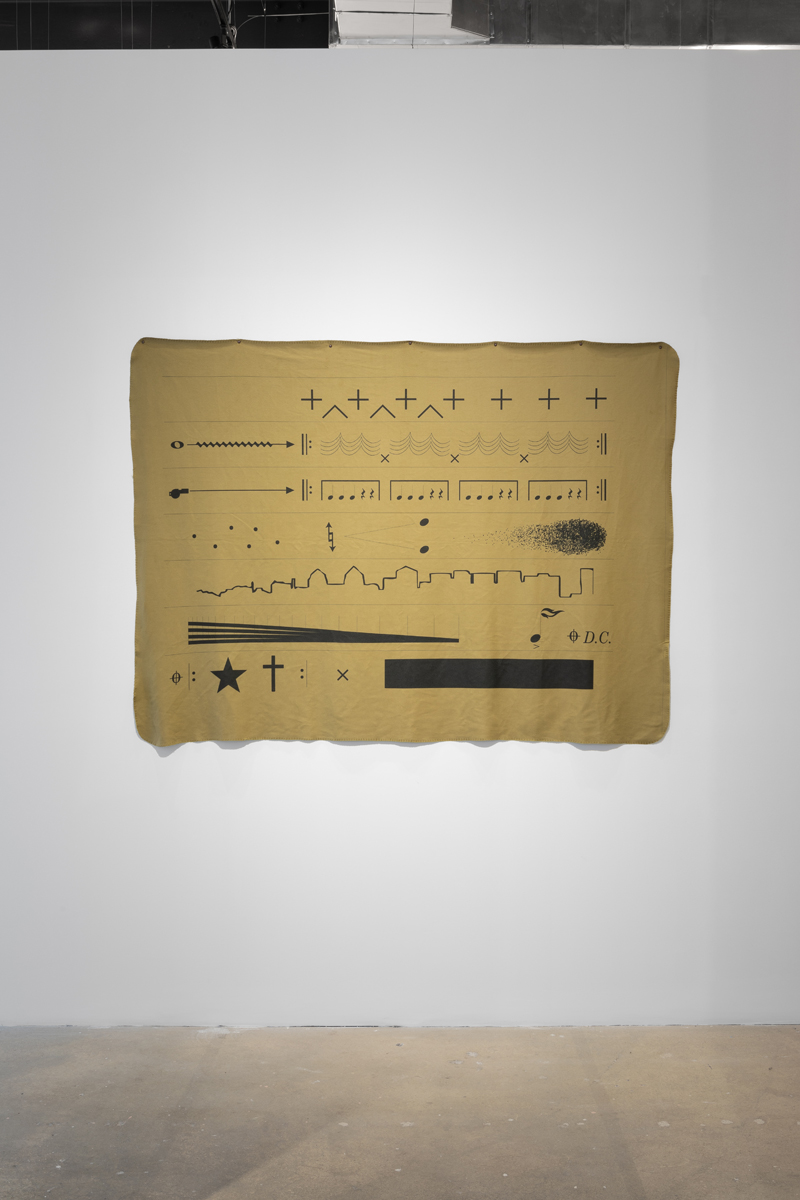
Raven Chacon: A Worm’s Eye View from a Bird’s Beak, installation view. Courtesy Swiss Institute. Photo: Daniel Pérez. Pictured: American Ledger No. 1 (Army Blanket), 2020. Score for performance, unique army blanket, and digital print.
Varied in appearance, spanning twenty-five years, the sometimes very moving, sometimes more subtly affecting conceptual and sound-based works assembled here are united by a philosophical throughline. Objects, installations, instructions, audio recordings, and videos show, in embodied and aural ways, how all things exist—culturally, socially, temporally, and ecologically—in relation. Chacon, who was classically trained as a pianist (and went on to play in noise bands), approaches counterpoint nonclassically in service of his spiritual-aesthetic-political aims, as a compositional technique with metaphorical, even allegorical functions—with implications for almost everything he does. He conceives of counterpoint as not (only) a mode of polyphonic arrangement that incorporates contrary motion and moments of consonance, but as a dialectical, collaborative, morphing, and interspecies zigzagging. The initially terse, matter-of-fact prose of “Being in a position” opens onto an expansive, poetic vision of the contrapuntal at its end. “To practice counterpoint is to be a teacher and forever a student, to find your location in the universe,” he concludes, “somewhere between the inside of the earth and the middle of the sky.”
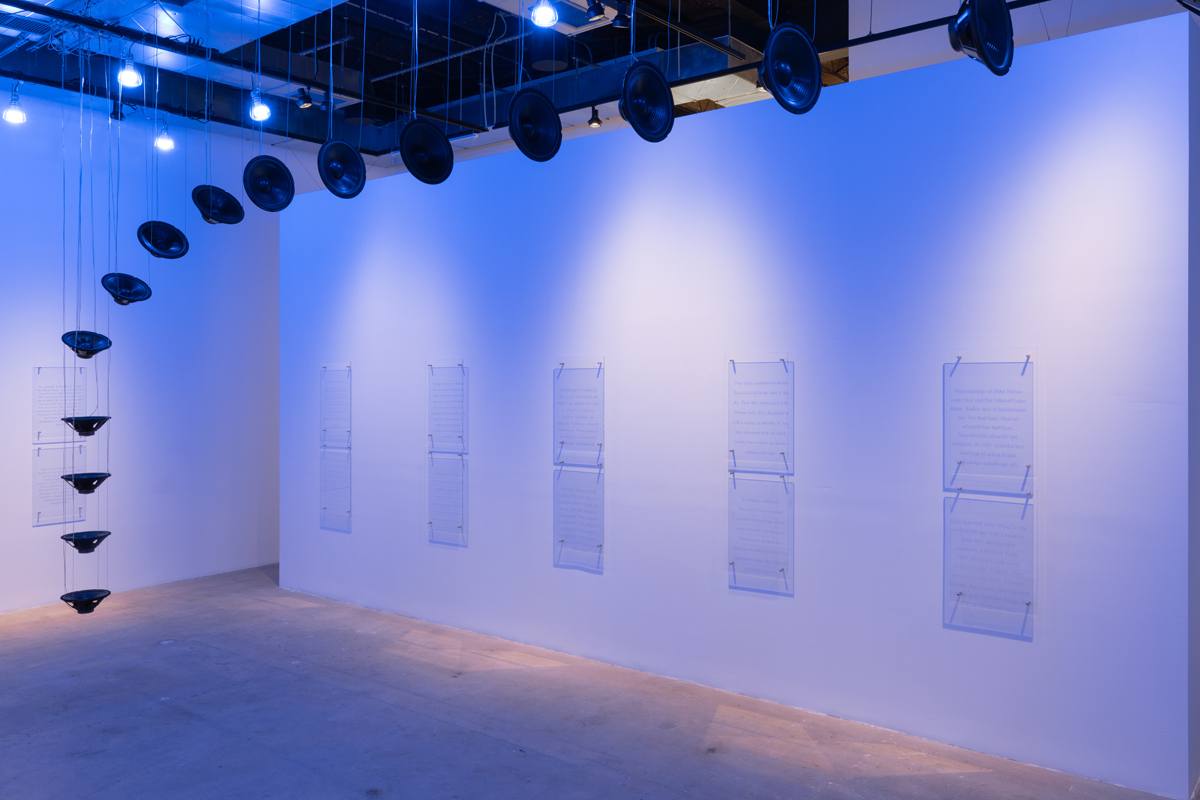
Raven Chacon: A Worm’s Eye View from a Bird’s Beak, installation view. Courtesy Swiss Institute. Photo: Daniel Pérez. Pictured: Still Life No. 3, 2015. Glass panels engraved with text, aluminum mount spacers, speakers, stereo amplifiers, stereo delay unit, audio track, and color timed-LED light arrays.
A Worm’s Eye View from a Bird’s Beak fills two uncrowded floors and extends onto the building’s terrace with a mural blanketing two perpendicular, upper-level exterior walls. The outdoor, in situ work, Vertical Neighbors (2024), a large-scale black-and-white score (related to a performance scheduled for April 7), is best seen from a worm’s eye view, from across the street, looking up. Still Life No. 3 (2015) is an installation made from text-engraved glass panels mounted on the walls and speakers suspended in an arcing formation in the center of the room, lifting from the ground and pointing northward, like migrating birds. A recording of a woman’s voice plays, overlapping with itself, converting what might be a univocal, linear account into an experience of panoramic simultaneity. She tells the Diné creation story, which progresses through multiple worlds (an English translation appears on the surrounding transparent panels).
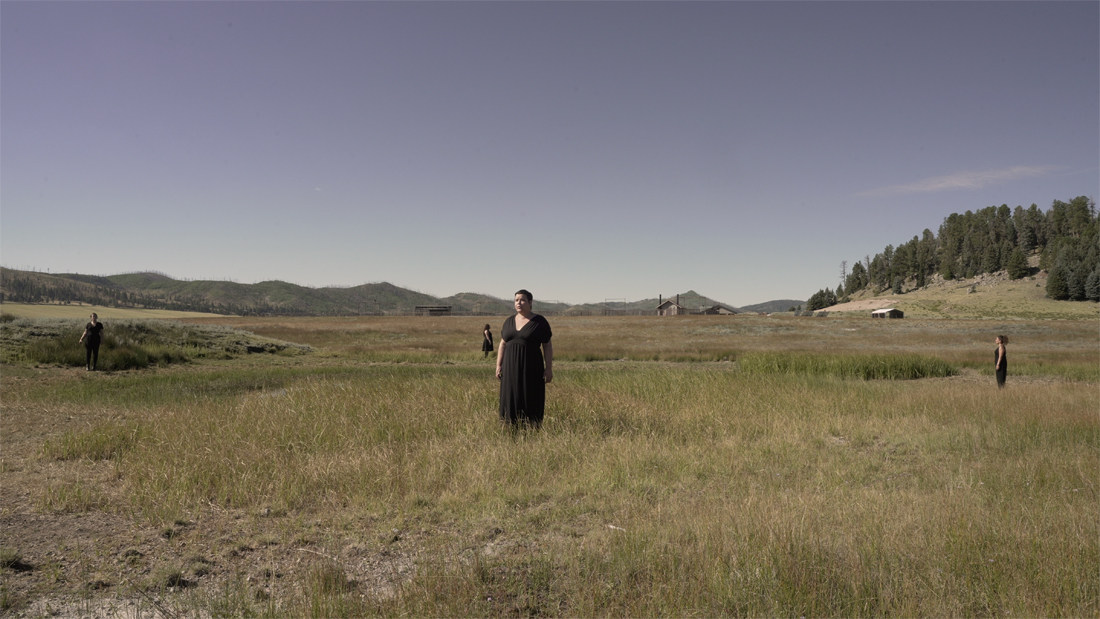
Raven Chacon, For Four (Caldera), 2024 (still). Four-channel video and audio. Courtesy the artist.
Images and evocations of sky and sweeping landscape define the overall feeling of the exhibition; the scenery itself becomes a score to read and interpret in the new commission For Four (Caldera). On the second floor, in an open enclosure formed by a diaphanous curtain, a quartet of monitors, arranged to face each other, display a multipart film. Four women, encircling a pond in a volcanic crater in New Mexico, prompted by the artist to “sing the horizon line,” perform an improvised canon of sustained, converging, oscillating tones. In place of the colonial import of Western musical notation, the texture and topography of the prairie and geological timescale of the American Southwest direct its inhabitants in song. This most recent piece is rather beautifully set up by the earliest series here, Field Recordings (1999). Playing on the ethnological documentary evoked in its title, Chacon literally recorded fields, or remote natural sites (also in the Southwest), where “nothing” is happening. He then turned up the volume to its maximum level, so that the noise generated by land, by its stillness, might be contemplated as a roar in headphones.
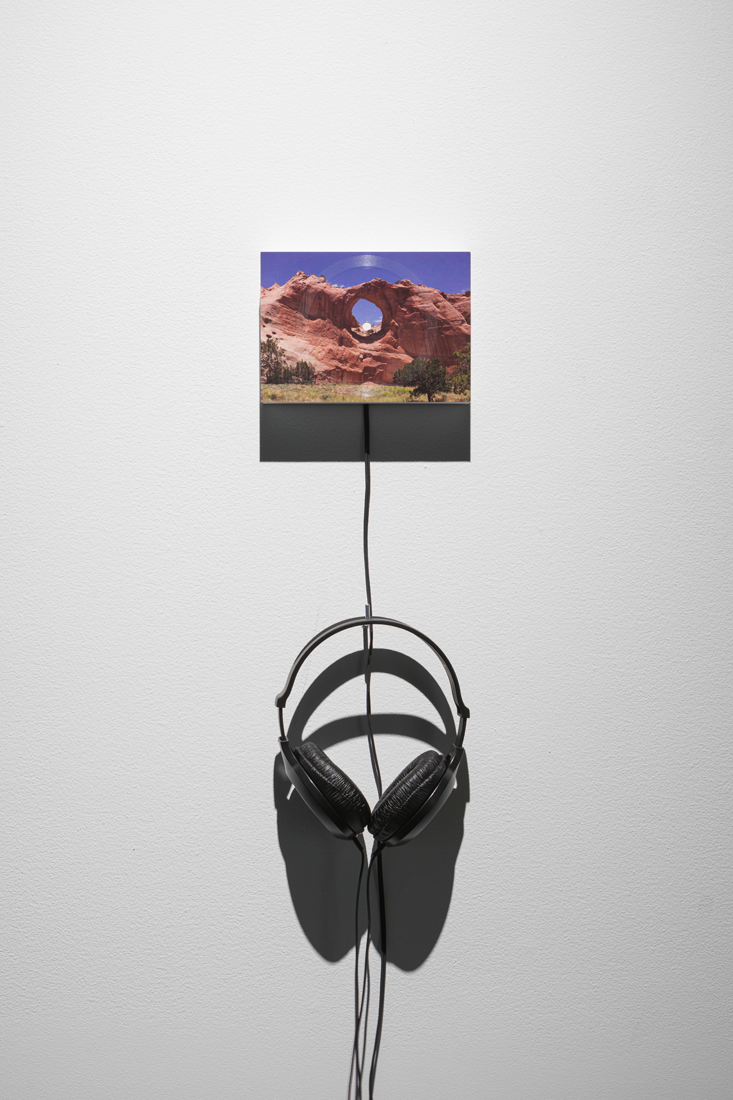
Raven Chacon: A Worm’s Eye View from a Bird’s Beak, installation view. Courtesy Swiss Institute. Photo: Daniel Pérez. Pictured: Field Recordings (Window Rock, 4:00am), 1999. Audio, headphones, and flexi disc.
Chacon does not reject outright the dominant notational system’s staves, time signatures, and durational values; he uses them sometimes. And his invented—more maplike and pictographic—musical language, which he supplements with straightforward descriptive or explanatory text, tends to reference the form of a conventional score even when departing from it significantly (as in American Ledger No. 1). The show’s most dramatic and jarring composition, Report (2001/2015), is both dispassionately expressed as framed pages of sheet music and documented as a performance of diverse shooters, who bear an array of firearms, in an exquisitely filmed and edited video. On a sunny, breezy day, a line of eight people fire weapons of various calibers in choreographed fusillades. Watching the almost-four-minute piece on loop, my perception of the gunpeople, whether their stance was one of conquest or defense, changed depending on the camera’s direction and framing, until the guns became, finally, neutral instruments of tuned percussion, playing in counterpoint. It seemed, in the end, a cinematic exorcism of the Hollywood western and settler-colonial claims, remapping the arid landscape through sound.
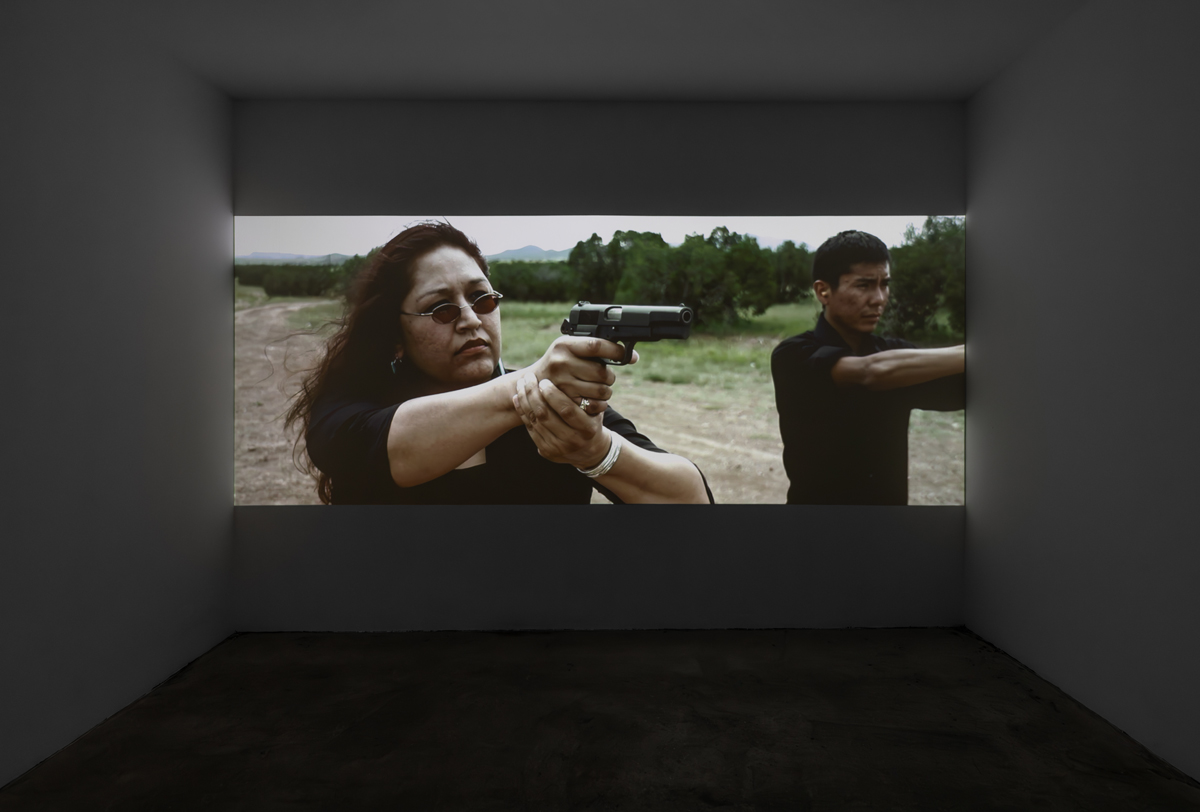
Raven Chacon: A Worm’s Eye View from a Bird’s Beak, installation view. Courtesy Swiss Institute. Photo: Daniel Pérez. Pictured: Report, 2015. Single-channel video, color, sound, 3 minutes 43 seconds.
While Report gains much of its thunderous power from its visual representation, some of Chacon’s most indelible work is represented by a slight, ephemeral placeholder, existing mostly in the imagination. Photocopied instruction-based pieces, free for the taking in the stairway, include the profound and essential Scream Out Of Each Window (2005), which reads “For a family to perform, / For as long as they want, / In a tall building, / On different levels, toward the same direction / Scream out of each window.” And the unassuming Still Life No. 4 (2017/2024) might be easily missed.
For this new iteration of a previously executed work, the artist recorded a single hit of a Diné drum, which is held in the collection of the Natural Museum of the American Indian in Washington, DC. Important to Chacon was its dormancy; it had not been “played for a long time.” (The wall label is mysteriously ambiguous.) With its materials listed as simply “reclaimed sound,” and its medium as “infinite loop,” Still Life No. 4’s meaning is made through its simultaneous installation in five far-flung places (including, in addition to Swiss Institute, the Navajo Nation Museum and the Nordnorsk Kunstmuseum, where this exhibition travels next). The farther away you are from the drum, the slower the looped hit plays. Chacon has adjusted the tempo to signal your relationship—in space but perhaps in other ways also—to the remote instrument, which has been woken, at least for a moment, from its artifactual slumber. Presented unremarkably as wall text and a pair of headphones, the piece is nevertheless remarkable, suggesting something like spiritual reverse-echolocation, using the call of a distant object to find your place, or your position, in the universe.
Johanna Fateman is a writer, art critic, and musician in New York.